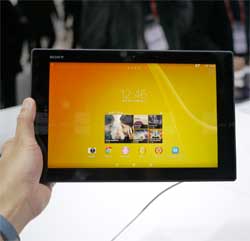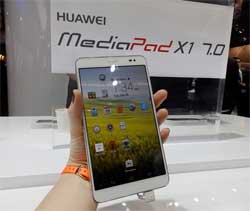
Related
Top stories




Four years after their launch, tablets remain overwhelmingly stuck at home and connected by WiFi, frustrating mobile operators who are deprived of a potential new source of revenue.
At the Mobile World Congress in Barcelona, Spain, manufacturers such as Japan's Sony, China's Lenovo and Taiwan's Asus again unveiled a range of new tablet models, now considered essential to their mobile device offerings.
Sony Mobile revealed its Xperia Z2, proudly describing it as "the world's slimmest and lightest waterproof tablet".
"It is perfect if you want to take it into the bathtub, to the beach, to the pool," Sony Mobile official Almos Szabo said at the Japanese manufacturer's stand in the world's largest mobile industry fair.
"The ease with which tablets can be used outside is always stressed by manufacturers," said Julian Jest, analyst at the technology research house Informa.
"During the last iPad launch, Apple showed a promotional video with thousands of different ways that people can use their iPad," Jest said.
He said the advert depicts doctors, mountain bikers and even surfers using the iPad. "However, iPads are still used mainly in the home, streaming media or movies," Jest said.

According to Informa, only 20% of tablets are connected to the mobile network, the rest relying on WiFi. The classic profile of a tablet user, is actually a person lounging on the sofa watching videos or playing electronic games.
In 2012, a poll by Google showed that only 21% of users took their tablets out of the home.
Technology research group Gartner found in a September 2013 survey that people use their tablets mostly between 7pm and 10pm, probably while watching television.
"Tablets are not typically used as a mobile accessory carried around by owners," said Lawrence Lundy, analyst at Frost & Sullivan technology consultants.
"We see that a lot of the tablets are being used for video consumption because it is mainly at home and it does not have a 3G connection," Lundy said.
For mobile operators, that means significantly less revenue than they had hoped for.
"It primarily comes down to costs, I think," said Nick Dillon, analyst at the research group, Ovum. "For the customers, there are two costs involved: the cellular-enabled tablets are more expensive, there is a kind of cost premium in terms of acquisition, and then on top of that, there is obviously the cost of data."
Analysts said the operators have not been sufficiently creative, often proposing plans that are as costly as those for smartphones.

"I am not sure if operators see it as a challenge or a blessing," said Carolina Milanesi, analyst at consumer research group Kantar Worldpanel.
"It seems clear that tablets are mostly used as entertainment devices which would suggest a potential bandwidth drain on video consumption," she said.
In other words, if all the tablets were connected, 3G networks would quickly be overloaded.
Tablets may finally break free of the home, however, as sales grow of mini tablets, which are easier to carry around. Manufacturers launched a string of these devices in Barcelona.
Chinese manufacturer Huawei showed off its MediaPad X1 and Finnish manufacturer Nokia revealed its XL, for example, both of which will allow users to make telephone calls, too.
The latest, super-fast, fourth-generation network will also help, analysts said.
"More 4G connectable tablets will probably mean less use of WiFI," said Jean-Laurent Pitou, head of communications, media and technology at research group Accenture.
"But this would also require network costs to adapt, with cheaper plans for consumers," Pitou cautioned.
Source: AFP via I-Net Bridge

For more than two decades, I-Net Bridge has been one of South Africa’s preferred electronic providers of innovative solutions, data of the highest calibre, reliable platforms and excellent supporting systems. Our products include workstations, web applications and data feeds packaged with in-depth news and powerful analytical tools empowering clients to make meaningful decisions.
We pride ourselves on our wide variety of in-house skills, encompassing multiple platforms and applications. These skills enable us to not only function as a first class facility, but also design, implement and support all our client needs at a level that confirms I-Net Bridge a leader in its field.
Go to: http://www.inet.co.za